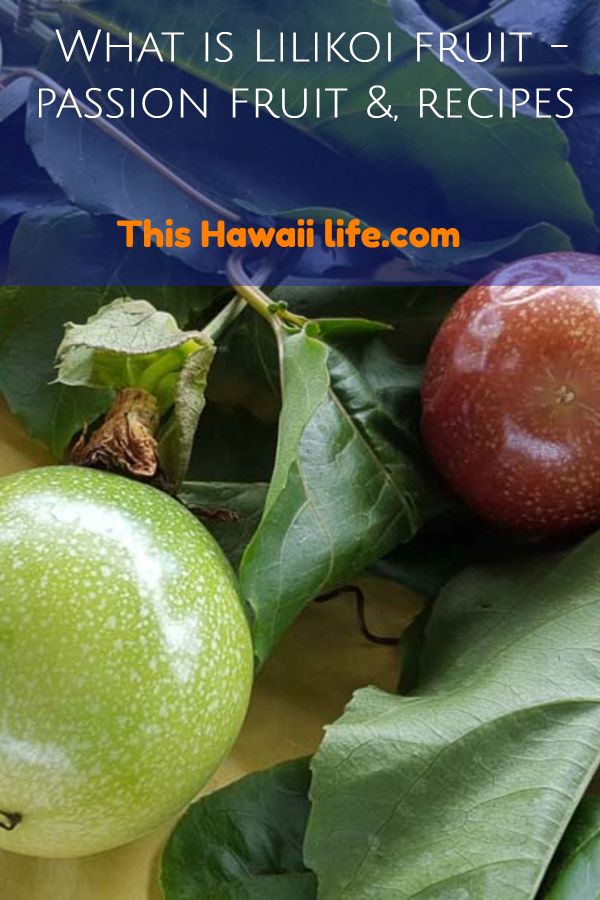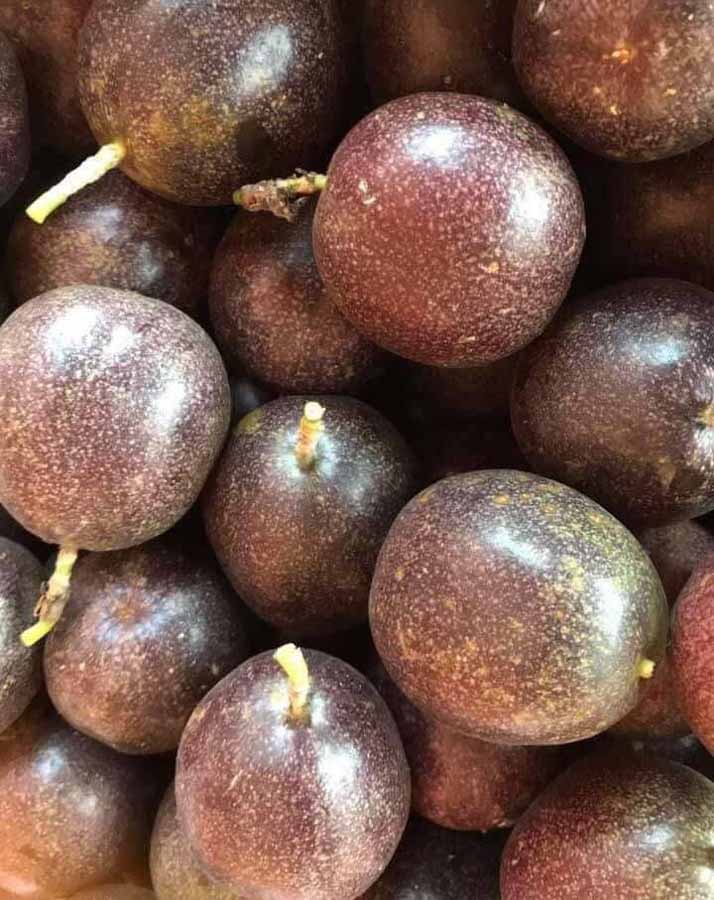Try Lilikoi Fruit or Passion Fruit in Hawaii

Lilikoi Fruit and Why It’s Hawaii’s Favorite Flavorful fruit – when to harvest, where to buy them, how to eat and some fun recipes to try
In this post we share everything about the delicious Lilikoi fruit. Lilikoi also known as passion fruit is an amazing fruit that can be made into a variety of sweet or savory dishes like the recipes we share below.
Lilikoi fruit from Hawaii is one of those versatile tropical fruits that can be eaten raw or used in a variety of sweet to savory dishes, exotic tropical drinks to, tasty snacks and even some delicious entrees. In this quick guide, we share all the inside scoop, history and even recipes to make using this flavorful fruit below.
Check out some of the history, healthy benefits and these cool lilikoi fruit and recipes for you to make some delicious savory or sweet dishes below.
Delicious Lilikoi fruit – delicious passion fruit, sweet and savory recipes

What is Lilikoi fruit aka Passionfruit?
Lilikoi fruit or passionfruit is a yellow passion flower fruit known as Passiflora edulis forma flavicarpa grown in Hawaii. It is a vine that creates beautiful flowers and then some edible seed pods that can be eaten raw or used in a variety of drinks, desserts to even savory dishes.
There is also a purple variety of fruit grown on the islands that is also used for different purposes or even eaten raw.
The flowers of the passionflower are truly stunning on both the purple and yellow varieties found on the island with five white petals and striking purple and white leaves and they yellow stamens that totally pop. After the flower dies, the fruit pod starts to develop into its egg shape from 1 inch to 3 inches wide and a thick shell colored from purple to orange or yellow colored.
What does lilikoi fruit taste like?
Inside the fruit pod are the juicy flesh with dark seeds and the fruit can range from tart to sweet tasting. The seed pods are ready when they reach a certain size and just fall off the vine and ready to harvest.
The edible parts of the fruit are basically the pulp and seeds of insides, the white flesh is also edible but very bitter so avoid getting any of the white insides.
Lilikoi produces fruit year-round but has a big flush during the summer season when one plant can bear hundreds of fruits.
Here’s a video showing the inside and taste of a raw lilikoi below and how truly flavor filled this fruit is.
Pin and save this post for later

How do you pronounce Lilikoi
Very simple and easy – Lili like a flower and koi like a fish combined into lilikoi

When is lilikoi fruit season?
Typically lilikoi season has a long producing time frame in Hawaii and lasts from June until January on the islands. Carpenter and honey bees are the typical pollinators of the fruit and when the ripe fruit ripens, it typically falls to the ground and can be harvested and used right away.
When, lilikoi is in season, you’ll see it at the farmers market, fruit stands, groceries along with some delicious, prepared desserts or savory dishes starring this popular fruit.
Here’s a lilikoi (passion fruit) seasonal availability chart broken down by Hawaiian island and general harvest seasons:
Lilikoi Seasonal Availability in Hawaii by Island
| Island | Peak Season | Secondary Season | Notes |
|---|---|---|---|
| Oʻahu | July – November | March – May | Yellow variety is more prevalent. Often found wild in mauka (upland) areas. |
| Maui | August – December | February – April | Both yellow and purple types grown, especially in cooler Upcountry regions. |
| Kauaʻi | June – October | January – March | Yellow lilikoi thrives in the island’s humid and tropical climate. |
| Hawaiʻi (Big Island) | July – December | March – May | Purple lilikoi is more common in higher elevations like Waimea or Volcano. Yellow thrives in Hilo and Kona. |
| Lānaʻi & Molokaʻi | July – November | February – April | Limited commercial production; mostly backyard or wild harvesting. |
| Niʻihau & Kahoʻolawe | Not commercially tracked | Not commercially tracked | Wild or minimal cultivation, no formal harvest seasons reported. |
Notes:
- Yellow lilikoi tends to fruit year-round in warm areas but with peak abundance in summer and early fall.
- Purple lilikoi has a more defined season, generally maturing a little later, and is more temperature sensitive.
- Harvest seasons can vary slightly based on elevation, rainfall, and microclimates.
- Lilikoi vines often flower several times a year, leading to sporadic availability outside of peak season, especially in wetter regions.
How to eat Lilikoi fruit (passionfruit)
Basically, to eat lilikoi fruit you cut through the center and scoop out the inside seeds and runny fruit, mostly juicy flesh. The seeds are also edible so you can eat with the juice and flesh. Can you eat the lilikoi seeds ? Most locals here eat the entire seeds and flesh from the cut rind. Or you can scoop it out and use this as a basic ingredient for a variety of sweet or savory dishes. If you don’t like the seeds you can always spit them out when you scoop out the fruit.
Look for thick skin and the fruit fills heavy meaning it has a lot of fruit. Avoid fruit with wrinkled skin showing decline in the fruit and starting to get over ripe and maybe sour fruit. It is easy to just cut the fruit in half and scoop out the flesh inside to eat or use as an ingredient.
Storing Lilikoi Fruit
Lilikoi can last from 2 to 3 weeks in the kitchen. If it is too hot, then you can place directly into a fridge for storage. The Lilikoi pulp can also freeze very well.

History of Lilikoi fruit in Hawaii
Originating from Latin America and named by the early Christian Missionaries calling it the flower of the five wounds for the crucifixion and passion of Christ and the corona symbolizing the crown of thorns. The passionflower is now grown in all tropical locations with many common names like lilikoi in Hawaii, Chinola in Puerto Rico and Marcuya in Ecuador and Brazil, Granadilla in Mexico. The missionaries collected the seeds and grew them in many tropical environments where the plant did well in these environments.
Lilikoi was introduced to Hawaii in from South America and came to Hawaii in the 1920s. When Lilikoi was introduced to Hawaii, they were brought to a district in East Maui called Lilikoi Gulch and the name stuck for the yellow fruit better known as (Passiflora edulis forma flavicarpa).
The passionflower fruit is one of the most popular fruits being grown in many home gardens and also has naturalized in many wild areas of the islands. Hawaiian fruit in season can be found at many local farmers markets, roadside stands or little mom and pop markets or you can pick them wild if you see them.

Health benefits to eating Lilikoi fruit
Not surprising, Lilikoi or passion fruit is a great fruit to have with so many health and nutritional benefits. The lilikoi fruit is packed with vitamins and nutrients below:
Nutritional Data
Vitamin C – Lilikoi is filled with Vitamin C and is a powerful antioxidant that prevents colds, lowers cells from damage and other cancer causing elements along with helping to make blood vessels, collagen, muscles and cartilage and keeping skin young.
Vitamin A – the pulp and seeds contain VItamin A which keep eyes and cells healthy, aids in reproduction and immunity.
Dietary Fiber – Lilikoi fruit is filled with fiber which is important with lowering cholesterol, heart disease, certain cancers, diabetes and a healthy bowel
Essential fatty acids like linoleic and oleic acids that protect the skin
Riboflavin and niacin and a variety of vital elements for healthy skin growth and complexion.
Nutrients – lilikoi fruit is loaded with nutrients that includes phosphorus, calcium, magnesium, folate and potassium.
Check out more details to health and fruit benefits here for more details and information.
Here’s a recap of the benefits to lilikoi in this video below explaining how amazing this fruit is.
Lilikoi fruit comparative information between yellow and purple varieties
Here’s a comparative outline of lilikoi (passion fruit) focusing on the yellow vs. purple varieties:
1. Appearance
- Yellow Lilikoi
- Larger in size, round to oval shape
- Smooth, thick, bright yellow skin when ripe
- Purple Lilikoi
- Smaller and rounder
- Thin-skinned with deep purple to dark maroon color
2. Flavor Profile
- Yellow Lilikoi
- More acidic, tart, and tangy
- Stronger citrus-like punch
- Purple Lilikoi
- Sweeter and milder
- Less acidic with floral undertones
3. Aroma
- Yellow
- Bold, intense tropical scent
- Purple
- Subtler, more fragrant and perfumed
4. Seeds & Pulp
- Yellow
- Contains more pulp and slightly larger seeds
- Juice yield is higher per fruit
- Purple
- Less pulp overall
- Seeds are smaller and more delicate
5. Growth & Climate
- Yellow
- Thrives better in tropical lowland areas (hotter climates)
- More vigorous vine growth
- Purple
- Prefers cooler, highland areas or subtropical climates
- Grows slower but is more cold-tolerant
6. Uses
- Yellow
- Commonly used for commercial juice production due to high yield
- Great for curds, sauces, marinades
- Purple
- Preferred for fresh eating due to sweeter flavor
- Popular in desserts, cocktails, and jams
7. Availability in Hawaii
- Yellow
- More commonly grown and found in the wild across Hawaii
- Purple
- Less common, often cultivated in home gardens or specialty farms

What to make with Lilikoi fruit – yummy recipes
This versatile fruit can be made into so many different things like juice, cocktails, syrups and jams, sweets and even savory dishes. The fruit is typically separated from the seeds or used with the seeds for a variety of dishes. For lilikoi juice, you strain and separate the seeds from the pulp. This might be a little strong and sour tasting so if you want Fresh lilikoi juice, adding some water, seltzer or other juice to make it not so concentrated and sour in my opinion is necessary.
But used as a basic ingredient for a variety of dishes, you can use lilikoi juice straight up from straining the pulp out and you can check out some of these lilikoi recipes below.

Delicious and easy to make Lilikoi butter, this easy video recipe shows you how to make this and use it for many types of dishes
So good lilikoi creme brulee, this recipe is a tropical fruit stunner that impresses even die hard foodies.
Popular and easy to make lilikoi fruit bars, here’s a delicious video recipe to try out that always impresses anyone.
Refreshing Lilikoi fruit juice is a classic and this video recipe shows you how to make it quick.
Delicious Lilikoi fruit Ice Cream, if you love tropical ice cream, watch this video recipe below.
Savory lilikoi butter and fish, this is a video recipe that anyone would love to eat.
How about some passionfruit (lilikoi) martini, check out this recipe to add some lilikoi into a classic cocktail and make it exciting!
Check out these other Hawaii food topics
Looking for more food inspiration about Hawaii, check out these other topics below for you to discover and enjoy.
Delicious Tropical fruits of Hawaii
Try some exotic Lychees in Hawaii
Visit the Farmers markets of Hawaii
Experience a Hawaiian chocolate making and tour
The best traditional Hawaiian foods
It Is Pineapple season in Hawaii
Delicious Avocados season in Hawaii
Conclusion on Lilikoi fruit in Hawaii
What did you think of the taste of this exotic lilikoi fruit – please share your thoughts about the taste below.
Thanks for checking out this post on Lilikoi fruit in Hawaii. Hope the post was informative and a must read article – if so please do share it with any of the social media buttons around the page.

Author Bio – Noel Morata
Having lived in Hawaii for over 15 years, I’ve explore all the historic and cultural sites, tried delicious traditional food, fusion and local style dishes and learned a lot about growing and sustainability.
Hawaii for me is ever changing and I visit many of these places regularly for inspiration, changes that may occur, seasonality and cultural practices. I hope to share with you all the fascinating things and places I’ve learned grown appreciation for and hope that you will find the information helpful to visiting the islands.
Lilikoi fruit is one of my favorites and I’ve had it in so many different sweet and savory dishes and even made a few dishes with this delicious fruit. Hope this post gives you some new information and recipes to try soon.


Yes and I loved it wish I could get it here in ohio
Lilikoi is a wonderful fruit that can be used for so many sweet and savory foods and drinks.